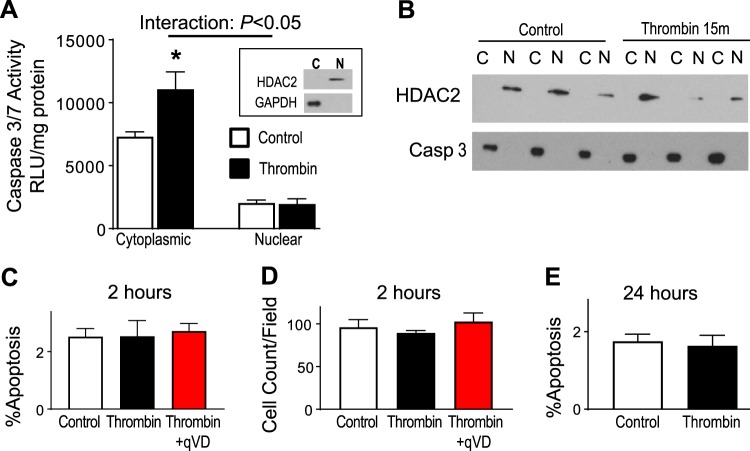Fig. 1.
Thrombin induces cytoplasmic caspase-3 (Casp 3) activation without cell death. A: human lung microvascular endothelial cells (HLMVECs) were exposed to 1.25 U/ml of thrombin for 15 min, and cells were harvested for cytoplasmic and nuclear preparations for assessment of caspase-3 activity. Cytoplasmic fractions demonstrate higher caspase-3 activity than nuclear fractions. Thrombin stimulation leads to an increase in caspase-3 activity only within the cytoplasmic fraction. Purity of cytosolic (C) and nuclear (N) fractions was assessed by exclusion of GAPDH and histone deacetylase (HDAC)-2 immunoblotting, respectively (inset); n = 3. B: nuclear and cytosolic fractions were immunoprobed for caspase-3 expression. Caspase-3 is present within the cytosolic fraction under control conditions and remains in the cytosol even after thrombin stimulation. C and D: HLMVECs were exposed to 1.25 U/ml of thrombin for 2 h, and Hoechst 33342 staining was used to measure apoptosis (by nuclear condensation and fragmentation) and cell dropout (by cell counts). Caspase inhibition in HLMVECs did not result in increased apoptosis with thrombin exposure (C) or cell dropout (D); n = 4; 4,925–5,502 cells counted/group. E: HLMVECs were exposed to 1.25 U/ml of thrombin for 24 h, and Hoechst 33342 staining was used to measure apoptosis. Thrombin exposure did not result in increased apoptosis; n = 4. RLU, relative light units; qVD, q-VD-OPH. *P < 0.05 vs. control.

